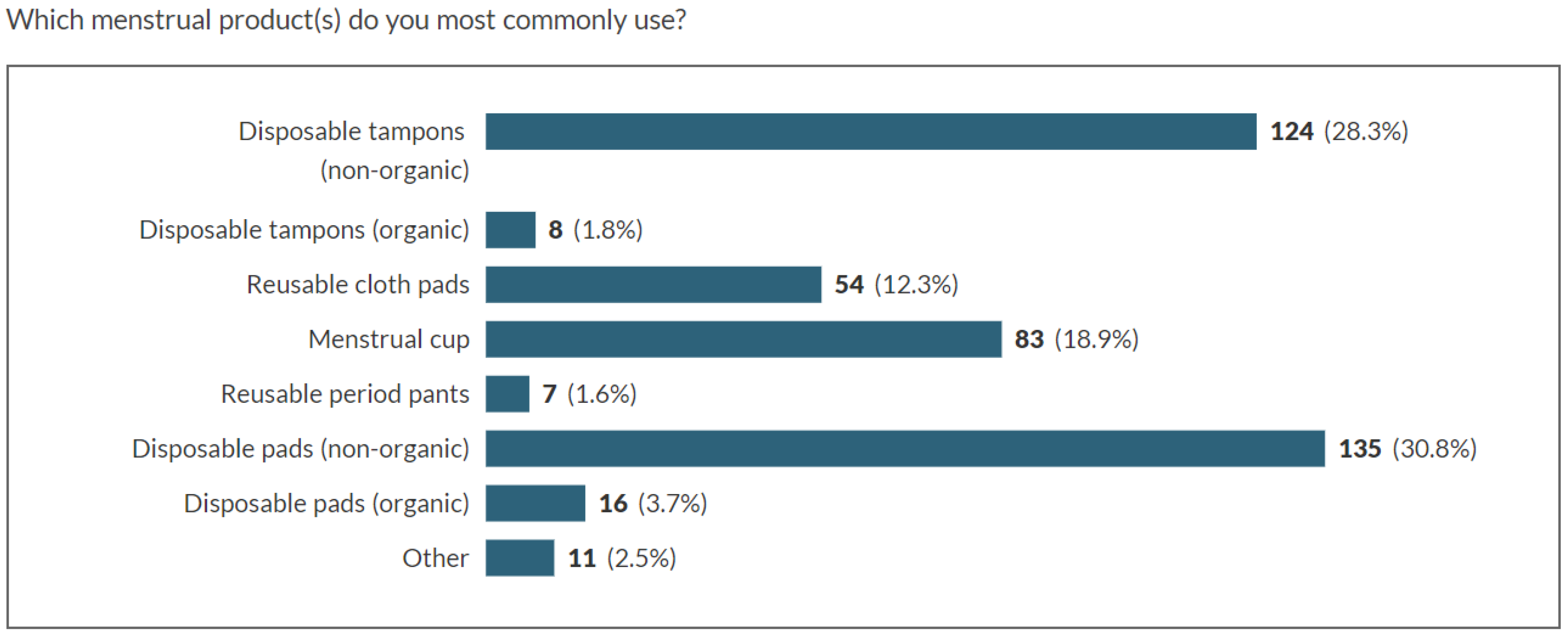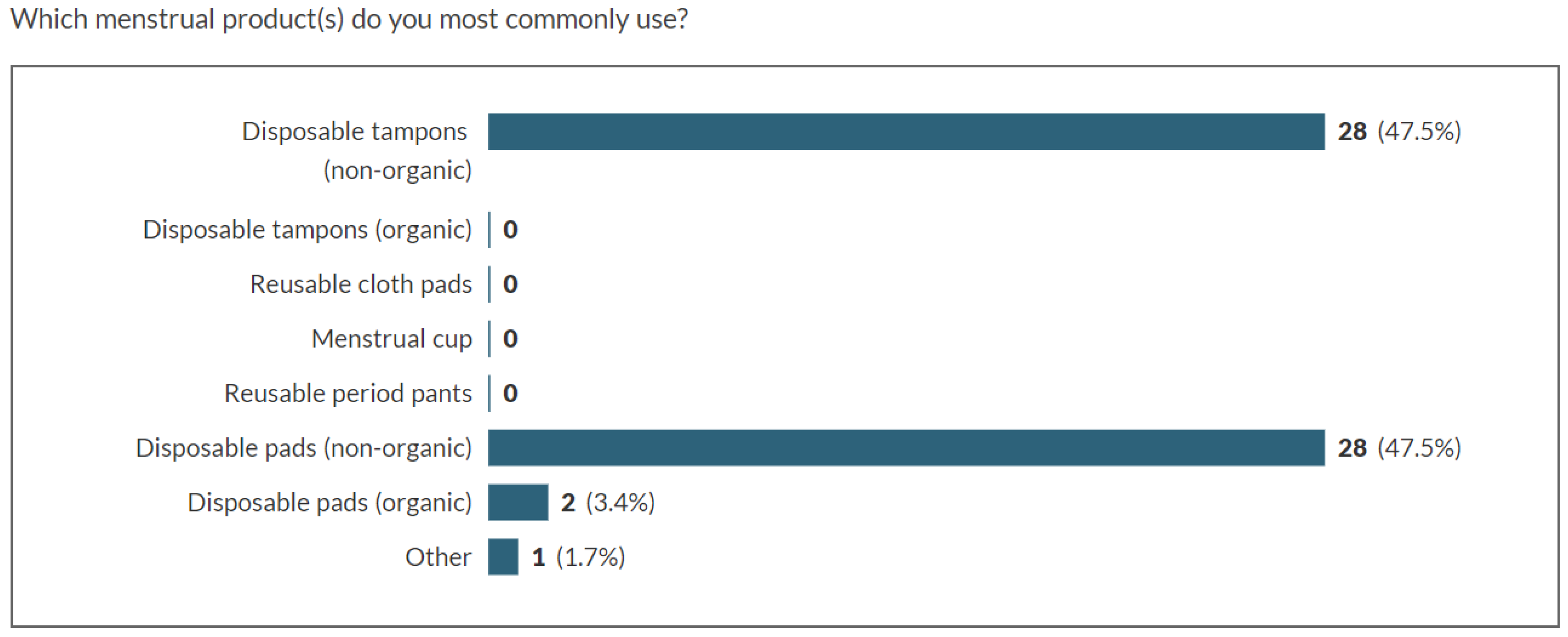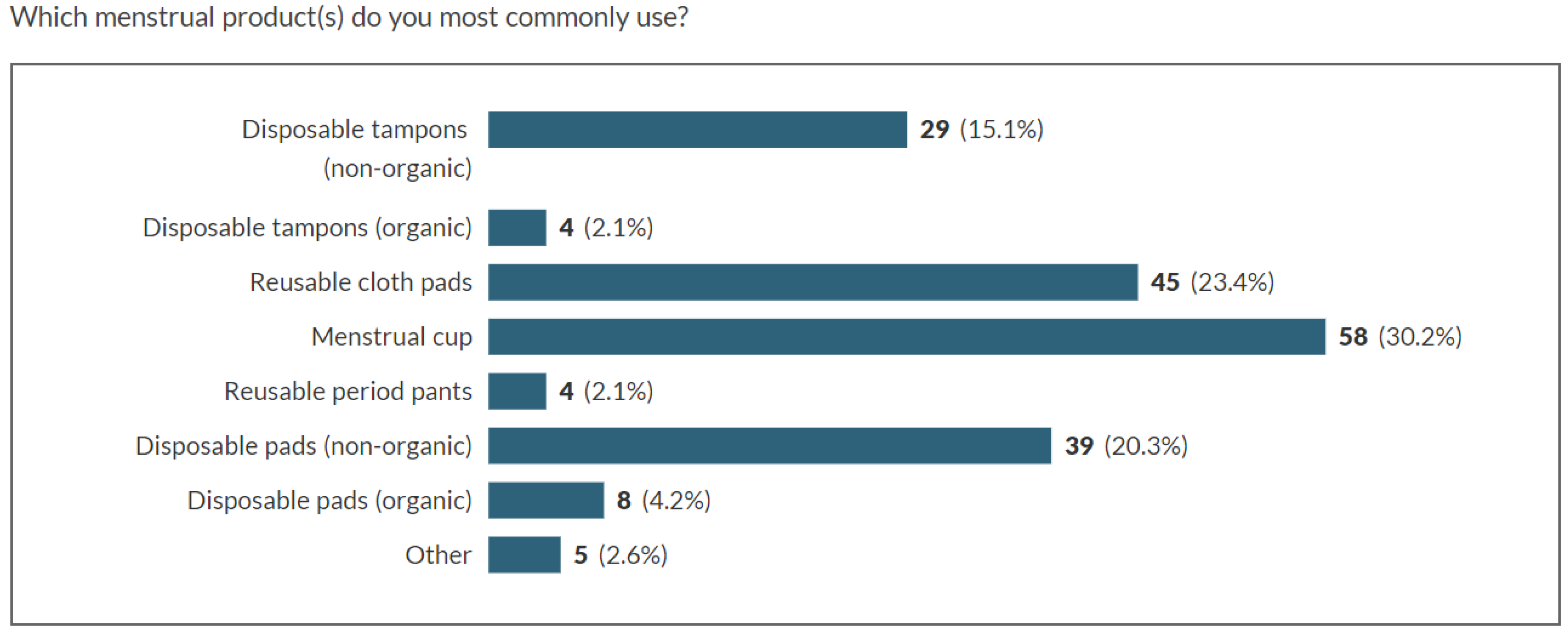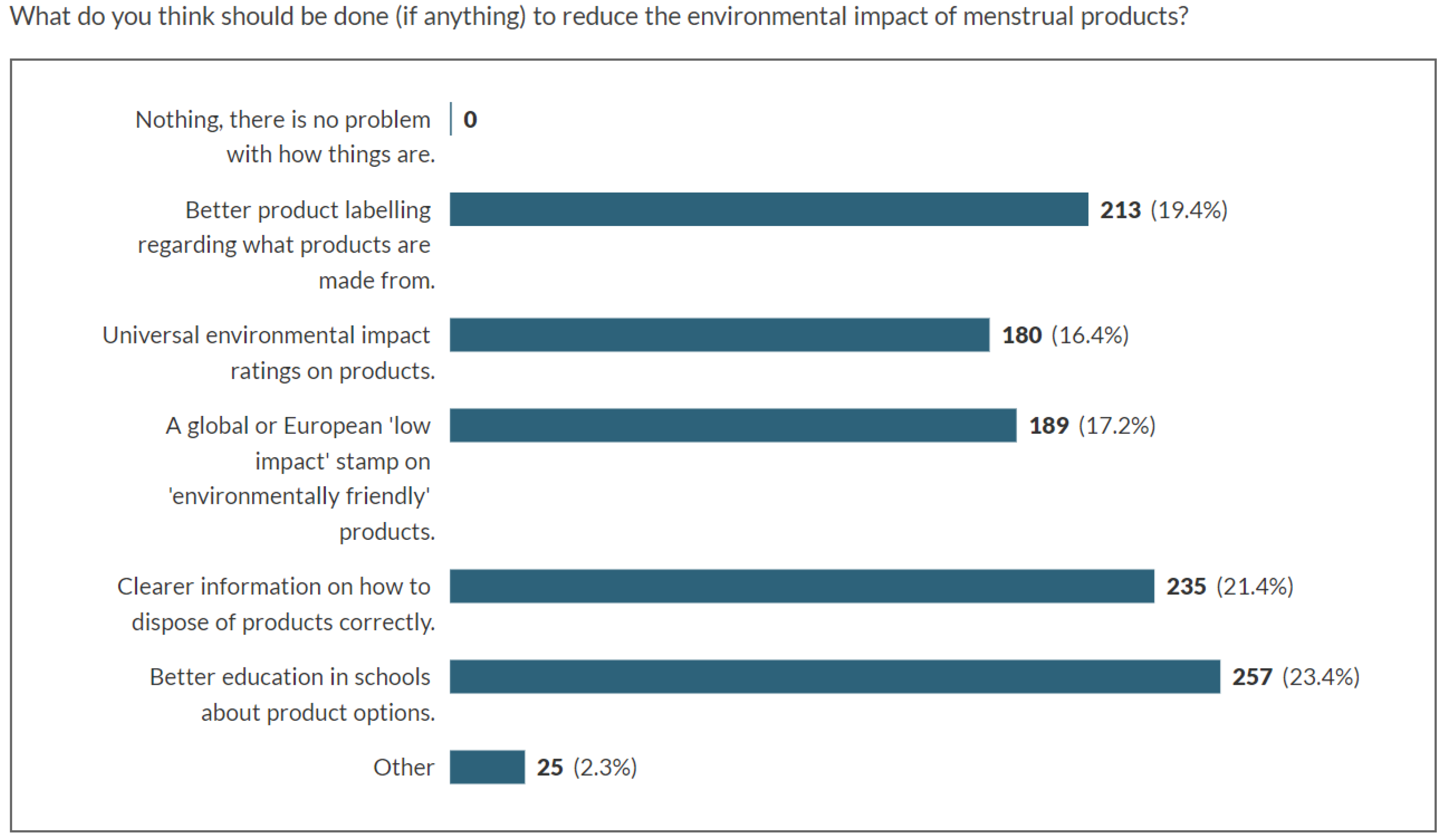A Study into Public Awareness of the Environmental Impact of Menstrual Products and Product Choice
Abstract
:1. Introduction
1.1. Factors Affecting Choice
1.2. Existing Research into Awareness of Environmental Impact
1.3. Study Aim and Research Question
2. Materials and Methods
2.1. Online Surveys
2.2. Focus Groups
2.3. Possible Sources of Bias and Mitigation Methods
3. Results
3.1. Online Surveys
3.1.1. Levels of Awareness
- 39% did not know that non-organic tampons can contain plastic.
- 64% did not know that organic tampons do not contain plastic.
- 85% did not know organic menstrual products can be composted.
3.1.2. Link between Awareness and Choice
3.2. Focus Groups
4. Discussion and Conclusions
Author Contributions
Funding
Conflicts of Interest
References
- Carpenter, E.J.; Smith, K.L. Plastics on the Sargasso sea surface. Science 1972, 175, 1240–1241. [Google Scholar] [CrossRef] [PubMed]
- Spinks, R. Disposable Tampons Aren’t Sustainable, But Do Women Want to Talk about It? The Guardian, 2015. Available online: https://www.theguardian.com/sustainable-business/2015/apr/27/disposable-tampons-arent-sustainable-but-do-women-want-to-talk-about-it (accessed on 10 July 2018).
- Freidenfelds, L. The Modern Period: Menstruation in Twentieth-Century America; John Hopkins University Press: Baltimore, MD, USA, 2010. [Google Scholar]
- Rosewarne, L. Periods in Pop Culture: Menstruation in Film and Television; Lexington Books: Lanham, MD, USA, 2012; Available online: http://libweb.anglia.ac.uk (accessed on 16 July 2018).
- Saz-Rubio, M.; Pennock-Speck, B. Constructing female identities through feminine hygiene TV commercials. J. Pragmat. 2009, 41, 2535–2556. [Google Scholar] [CrossRef]
- Bell, J. What Advertising Teaches Us about Periods. 2017. Available online: https://helloclue.com/articles/culture/what-advertising-teaches-us-about-periods (accessed on 4 July 2018).
- Raftos, M.; Jackson, D.; Mannix, J. Idealised versus tainted femininity: Discourses of the menstrual experience in Australian magazines that target young women. Nurs. Inq. 1998, 5, 174–186. [Google Scholar] [CrossRef] [PubMed]
- Berkely, K. The Intimacy of Commodities: Social Control, Subjectivity and Feminine Hygiene. Master’s Thesis, McMaster University, Hamilton, ON, Canada, 1981. Available online: https://macsphere.mcmaster.ca/bitstream/11375/10509/1/fulltext.pdf (accessed on 15 July 2018).
- Davidson, A. Narratives of menstrual product consumption: Convenience, Culture or commoditization? Bull. Sci. Technol. Soc. 2012, 32, 56–70. [Google Scholar] [CrossRef]
- Shure, N. Why Has It Taken the Menstrual Cup So Long to Go Mainstream? Pacific Standard, 2016. Available online: https://psmag.com/news/why-has-it-taken-the-menstrual-cup-so-long-to-go-mainstream (accessed on 16 July 2018).
- Ashley, R.; Blackwood, D.; Souter, N.; Hendry, S.; Moir, J.; Dunkerly, J.; Goldie, P. Sustainable disposal of domestic sanitary waste. J. Environ. Eng. 2005, 131, 206–215. [Google Scholar] [CrossRef]
- Radnor, A. “We’re Having a Menstrual Liberation”: How Periods Got Woke. 2017. Available online: https://www.theguardian.com/society/2017/nov/11/periods-menstruation-liberation-women-activists-abigail-radnor (accessed on 16 July 2018).
- Tampax (nd) Tampax Tampon Ingredients: What’s in Our Tampons? Available online: https://tampax.com/en-us/tips-and-advice/period-health/tampon-ingredients (accessed on 15 July 2018).
- Mazgaj, M.; Yaramenka, K.; Malovana, O. Comparative Life Cycle Assessment of Sanitary Pads and Tampons; Royal Institute of Technology: Stockholm, Sweden, 2006; Available online: https://www.researchgate.net/publication/265149999_Comparative_Life_Cycle_Assessment_of_Sanitary_Pads_and_Tampons_GROUP_6 (accessed on 10 July 2018).
- Natracare. Tampons: Why Choose Organic Tampons? 2018. Available online: http://www.natracare.com/products/tampons/ (accessed on 11 July 2018).
- Always (nd). What’s in Always Pads. Available online: https://www.always.co.uk/en-gb/tips-and-advice-for-women/your-first-period/always-pads-ingredients (accessed on 16 July 2018).
- Bodyform (nd). Ingredients. Available online: https://www.bodyform.co.uk/ingredients/ (accessed on 16 July 2018).
- Natracare. Natracare: Pads. 2018. Available online: http://www.natracare.com/products/pads/ (accessed on 16 July 2018).
- Bussey, C. “Fluffy vagina blankets”: How Reusable Sanitary Pads Became a Period Phenomenon. The Telegraph, 2015. Available online: https://www.telegraph.co.uk/women/womens-life/11871874/Period-product-Sanitary-pads-you-can-reuse.html (accessed on 16 July 2018).
- Weir, C. In the Red: A Private Economic Cost and Qualitative Analysis of Environmental and Health Implications for Five Menstrual Products. 2015. Available online: https://cdn.dal.ca/content/dam/dalhousie/pdf/science/environmental-science-program/Honours%20Theses/2015/ThesisWeir.pdf (accessed on 16 July 2018).
- Thinx. Thinx: Start Period-Ing Better. 2018. Available online: https://www.shethinx.com/pages/it-works (accessed on 2 September 2018).
- Edraki, F. Tampons, Pads, Menstrual Cups, Period Underwear: What’s Best for the Environment? 2017. Available online: http://www.abc.net.au/news/2017-10-27/which-period-product-is-best-for-the-environment/9090658 (accessed on 16 July 2018).
- Moss, R. Women Spend More Than £18,000 on Having Periods in Their Lifetime, Study Reveals. The Huffington Post UK, 2015. Available online: https://www.huffingtonpost.co.uk/2015/09/03/women-spend-thousands-on-periods-tampon-tax_n_8082526.html (accessed on 15 July 2018).
- Cooper, K.L. The People Fighting Pollution with Plastic-Free Periods. BBC News, 2018. Available online: https://www.bbc.co.uk/news/world-43879789 (accessed on 16 July 2018).
- Potter, A. Menstrual Cups and Period Underwear Review: Welcome to the Undieworld. Choice, 2016. Available online: https://www.choice.com.au/health-and-body/reproductive-health/womens-health/articles/menstrual-cups-and-period-underwear (accessed on 16 July 2018).
- Langston, N. Toxic Bodies: Hormone Disruptors and the Legacy of DES; Yale University Press: Newhaven, CT, USA, 2010. [Google Scholar]
- Lapidos, J. Will My Plastic Bag Still Be Here in 2507? How Scientists Figure Out How Long It Takes Your Trash to Decompose. 2007. Available online: https://slate.com/news-and-politics/2007/06/do-plastic-bags-really-take-500-years-to-break-down-in-a-landfill.html (accessed on 20 August 2018).
- Edwards, R. Seabirds Filled with Plastic Waste. 2004. Available online: http://www.robedwards.com/2004/12/seabirds-filled.html (accessed on 10 July 2018).
- Ross, C. Why Is There Plastic in Tampons? Huffpost UK, 2018. Available online: https://www.huffingtonpost.co.uk/entry/why-is-there-plastic-in-my-tampon_uk_5a96cc5be4b07dffeb6ec7bb (accessed on 12 July 2018).
- Wright, S.L.; Thompson, R.C.; Galloway, T.S. The physical impacts of microplastics on marine organisms: A review. Environ. Pollut. 2013, 178, 483–492. [Google Scholar] [CrossRef] [PubMed]
- Oosterhuis, F.; Papyrakis, E.; Boteler, B. Economic instruments and marine litter control. Ocean Coast. Manag. 2014, 102, 47–54. [Google Scholar] [CrossRef]
- Lusher, A.L.; McHugh, M.; Thompson, R.C. Occurrence of microplastics in the gastrointestinal tract of pelagic and demersal fish from the English Channel. Mar. Pollut. Bull. 2012, 67, 94–99. [Google Scholar] [CrossRef]
- Bhattacharya, P.; Lin, S.; Turner, J.P.; Ke, P.C. Physical adsorption of charged plastic nanoparticles affects algal photosynthesis. J. Phys. Chem. 2010, 114, 16556–16561. [Google Scholar] [CrossRef]
- Cole, M.; Lindeque, P.; Halsband, C.; Galloway, T.S. Microplastics as contaminants in the marine environment: A review. Mar. Pollut. Bull. 2011, 62, 2588–2597. [Google Scholar] [CrossRef]
- Hertwich, E.G. Consumption and industrial ecology. J. Ind. Ecol. 2005, 9, 1–6. [Google Scholar] [CrossRef]
- Oster, E.; Thornton, R. Determinants of technology adoption: Peer effects in menstrual cup-uptake. J. Eur. Econ. Assoc. 2012, 10, 1263–1293. [Google Scholar] [CrossRef]
- Koff, E.; Rierdan, J. Preparing girls for menstruation: recommendations from adolescent girls. Adolescence 1995, 30, 795–811. [Google Scholar] [PubMed]
- Borowski, A. Are American Women Turning to Reusable and Greener Menstrual Products Due to Health and Environmental Pollution Concerns? Master’s Thesis, Rochester Institute of Technology, Rochester, NY, USA, 2011. [Google Scholar]
- Pedrini, M.; Ferri, M. Socio-demographical antecedents of responsible consumerism propensity. Int. J. Consum. Stud. 2014, 38, 127–138. [Google Scholar] [CrossRef]
- Scullion, R. ‘Period Poverty’: Why No One Is Talking About Eco-Friendly Solutions. 2017. Available online: http://www.passblue.com/2017/11/30/period-poverty-why-no-one-is-talking-about-eco-friendly-solutions/ (accessed on 23 July 2018).
- Kent, R.J.; Allen, C.T. Competitive Interference Effects in Consumer Memory for Advertising: The Role of Brand Familiarity. J. Mark. 1994, 58, 97–105. [Google Scholar] [CrossRef]
- Carrigan, M.; Attalla, A. The myth of the ethical consumer—Do ethics matter in purchase behaviour? J. Consum. Mark. 2001, 18, 560–578. [Google Scholar] [CrossRef]
- Bobel, C. “Our revolution has style”: Contemporary menstrual product activists “doing feminism” in the third wave. Sex Roles 2006, 54, 331–345. [Google Scholar] [CrossRef]
- McKim, C. The Value of Mixed Methods Research: A Mixed Methods Study. J. Mixed Methods Res. 2017, 11, 202–222. [Google Scholar] [CrossRef]
- Morse, J.M.; Chung, S.E. Toward holism: The significance of methodological pluralism. Int. J. Qual. Methods 2003, 2, 1–12. [Google Scholar] [CrossRef]
- Online Surveys: Powerful, Flexible Online Surveys. Available online: https://www.onlinesurveys.ac.uk/ (accessed on 1 September 2018).
- City to Sea. Plastic Free Periods. 2017. Available online: https://www.youtube.com/watch?v=lsJjUzN_12o (accessed on 2 September 2018).
- Kelland, L. How to Break Down the Stigma and Taboo Around Menstruation. The Conversation, 2016. Available online: https://theconversation.com/how-to-break-down-the-stigma-and-taboo-around-menstruation-59751 (accessed on 1 August 2018).
- McHugh, M. The Chi-square test of independence. Biochem. Med. 2013, 23, 143–149. [Google Scholar] [CrossRef]
- Smithson, J. Focus Groups. In The SAGE Handbook of Social Research Methods; Alasuutari, P., Bickman, L., Brannen, J., Eds.; SAGE Publications Ltd.: London, UK, 2008; Chapter 21. [Google Scholar]
- Farqhuar, C.; Das, R. Are focus groups suitable for ‘sensitive’ topics? In Developing Focus Group Research: Politics, Theory and Practice; Barbour, R., Kitzinger, J., Eds.; Sage Publications: London, UK, 1999; Chapter 4. [Google Scholar]
- Boyatzis, R. Transforming Qualitative Information: Thematic Analysis and Code Development; Sage publications: London, UK, 1998. [Google Scholar]
- McPherson, M.; Smith-Lovin, L.; Cook, J. Birds of a feather: Homophily in social networks. Ann. Rev. Sociol. 2001, 27, 415–444. [Google Scholar] [CrossRef]
- Office for National Statistics. Internet Users in the UK: 2017. Available online: https://www.ons.gov.uk/businessindustryandtrade/itandinternetindustry/bulletins/internetusers/2017 (accessed on 2 August 2018).
- Consultancy UK. UK Smartphone Penetration Continues to Rise to 85% of Adult Population. 2017. Available online: https://www.consultancy.uk/news/14113/uk-smartphone-penetration-continues-to-rise-to-85-of-adult-population (accessed on 2 August 2018).
- Sax, L.; Gilmartin, S.; Bryant, A. Assessing response rates and non-response bias in web and paper surveys. Res. High. Educ. 2003, 44, 409–432. [Google Scholar] [CrossRef]
- Fisher, R. Social desirability bias and the validity of indirect questioning. J. Consum. Res. 1993, 20, 303–315. [Google Scholar] [CrossRef]
- NHS. Overview: Menopause. 2018. Available online: https://www.nhs.uk/conditions/menopause/ (accessed on 2 September 2018).
- European Commission. Proposal for a Directive of the European Parliament and of the Council on the Reduction of the Impact of Certain Plastic Products on the Environment. Brussels: 28 May 2018. Available online: http://ec.europa.eu/environment/circular-economy/pdf/single-use_plastics_proposal.pdf (accessed on 29 May 2018).
- Deloitte. The Deloitte Consumer Review: The Growing Power of Consumers. 2014. Available online: https://www2.deloitte.com/content/dam/Deloitte/uk/Documents/consumer-business/consumer-review-8-the-growing-power-of-consumers.pdf (accessed on 20 September 2018).





| Product | Brief Description |
|---|---|
| Inorganic tampon with/without applicator | Worn inside the body to absorb menstrual fluid. The main absorbent body of the tampon is commonly made from cotton or rayon and often has a thin outer layer of synthetic fibre (polyethylene and polypropylene) to prevent fibre loss and create a smoother surface. There is a cord attached for removal, made from polyester or polypropylene. Applicators can be made from card or plastic [13]. One tampon can be used for 4–8 h, then it should be disposed of in a bin [14]. |
| Organic tampon with/without applicator | Used in the same way as a non-organic tampon, but the main absorbent body of the tampon and the attached string is made from organic cotton. Applicators are made from cardboard [15]. One tampon can be used for 4–8 h then it should be disposed of in a bin or composted. |
| Inorganic disposable pads | Worn outside the body using an adhesive strip to fix the product to underwear. Made up of various layers. A permeable top layer made from a polymer such as polypropylene or polyethylene, an absorbent layer made of cellulose, a ‘super absorbent polymer’ or ‘smart foam’ inner core (different brands give different names to this part but do not reveal the ingredients) and a polyethylene bottom layer [16,17]. One pad can be used for 4–6 h depending on flow and should be disposed of in a bin. |
| Organic disposable pads | Worn in the same way as inorganic disposable pads, fixed to underwear with adhesive strip. Absorbent cellulose centre and cotton top layer. One pad can be used for 4–6 h depending on flow and should be disposed of in a bin or composted [18]. |
| Reusable pads | Worn outside the body and fixed to underwear using poppers. Made from layers of absorbent fabric. Can be made from natural fibres such as cotton and bamboo, or from synthetic fibres such as polyester. Pads can be worn for 4–6 h and should be washed after each use. They will last approximately 5 years [19]. |
| Menstrual cup | Worn inside the body to collect menstrual fluid. Made from medical grade silicone or natural rubber and available in two sizes. Cups can be worn for 12 h before emptying, should be sanitised after each monthly use and can last up to 10 years [20]. |
| Period pants | Worn as regular underwear. Can be made from natural fibres such as cotton or synthetic fibres. Contains a top layer of cotton, an inner layer of ‘super-absorbent’ fabric and an outer leak-resistant layer [21]. Products are available in a range of sizes, shapes and absorbencies, should be washed after each use and will last approximately 2 years [22]. |
| True/False Question | % with Correct Answer | ||
|---|---|---|---|
| High Awareness | Low Awareness | Average of All Participants | |
| It is OK to flush tampons (f)* | 89.2% | 59.5% | 80% |
| If an item is biodegradable there is no environmental impact (f)* | 90.8% | 61.9% | 81.7% |
| Non-organic tampons can contain plastic (t) | 68.5% | 59.5% | 68.3% |
| Disposable non-organic pads have the highest environmental impact because they generally contain the most plastic (t) | 70% | 64.3% | 69.7% |
| Menstrual cups can last up to 10 years (t)* | 80.8% | 35.7% | 62.7% |
| Cardboard tampon applicators can be recycled (f) | 42.6% | 40.5% | 38.5% |
| Organic tampons can be composted (t) | 15.4% | 11.9% | 16% |
| Manufacturers of menstrual products are not required to list ingredients (t) | 55.8% | 45.2% | 50.2% |
| Does the Item Contain Plastic? | % with Correct Answer | ||
|---|---|---|---|
| High Awareness | Low Awareness | Average of All Participants | |
| Disposable non-organic pads | 93.8% | 64.3% | 84.9% |
| Non-organic tampons | 61.4% | 52.4% | 54.5% |
| Organic tampon | 35.4% | 51.2% | 38.3% |
| Reusable cotton pads | 69.5% | 64.3% | 65.9% |
| Menstrual cup | 30.5% | 0% | 20.3% |
| Period pants | 35.7% | 35.7% | 32.8% |
© 2019 by the authors. Licensee MDPI, Basel, Switzerland. This article is an open access article distributed under the terms and conditions of the Creative Commons Attribution (CC BY) license (http://creativecommons.org/licenses/by/4.0/).
Share and Cite
Peberdy, E.; Jones, A.; Green, D. A Study into Public Awareness of the Environmental Impact of Menstrual Products and Product Choice. Sustainability 2019, 11, 473. https://doi.org/10.3390/su11020473
Peberdy E, Jones A, Green D. A Study into Public Awareness of the Environmental Impact of Menstrual Products and Product Choice. Sustainability. 2019; 11(2):473. https://doi.org/10.3390/su11020473
Chicago/Turabian StylePeberdy, Elizabeth, Aled Jones, and Dannielle Green. 2019. "A Study into Public Awareness of the Environmental Impact of Menstrual Products and Product Choice" Sustainability 11, no. 2: 473. https://doi.org/10.3390/su11020473
APA StylePeberdy, E., Jones, A., & Green, D. (2019). A Study into Public Awareness of the Environmental Impact of Menstrual Products and Product Choice. Sustainability, 11(2), 473. https://doi.org/10.3390/su11020473






